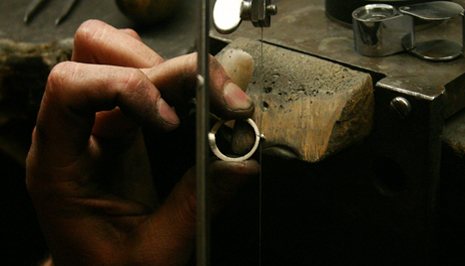
Rings are often cast in a steel mold, or by lost-wax casting.
Lost-wax casting - also known as 'investment casting' is one of the oldest known metal forming techniques going back about 5,000 years. This process can produce more complex shapes that would be difficult to do with die casting or sand casting. Basically it allows the jeweler to make anything in metal, that can be sculpted in wax.
After the wax model of the ring is made, it is attached using a wax rod called a 'sprue' to a 'sprue base' which is shaped like a funnel to allow the molten metal to enter the mold from the outside; this is then attached to a flask (mold cup or pour-cup) which forms a sealed container for the model. 'Investment' (a plaster type material) is mixed and poured into the mold cup surrounding the wax model entirely and allowed to set


Once the investment hardens the mold is complete and is ready to be heated to melt the wax out of the mold, leaving an exact negative impression of the original wax model in the plaster. This is the 'lost-wax' or 'burn out' process, where the entire method gets its name. The mold is now ready to use for casting. It is then filled with molten precious metals to make your wedding rings and engagement rings. For jewelry, due to the small amounts of metal used and the physics of surface tension, a centrifugal casting machine or a vacuum casting machine is used to force the molten metal into the mold and eliminate air pockets that would ruin the cast of the ring.
The casting is allowed to cool briefly and the flask 'quenched' in water, where the investment simply dissolves leaving behind the metal ring.
The final step is cutting off the metal sprue from the ring. The sprue's point of attachment is then filed down on all sides, sanded, and then polished so that it is no longer visible.